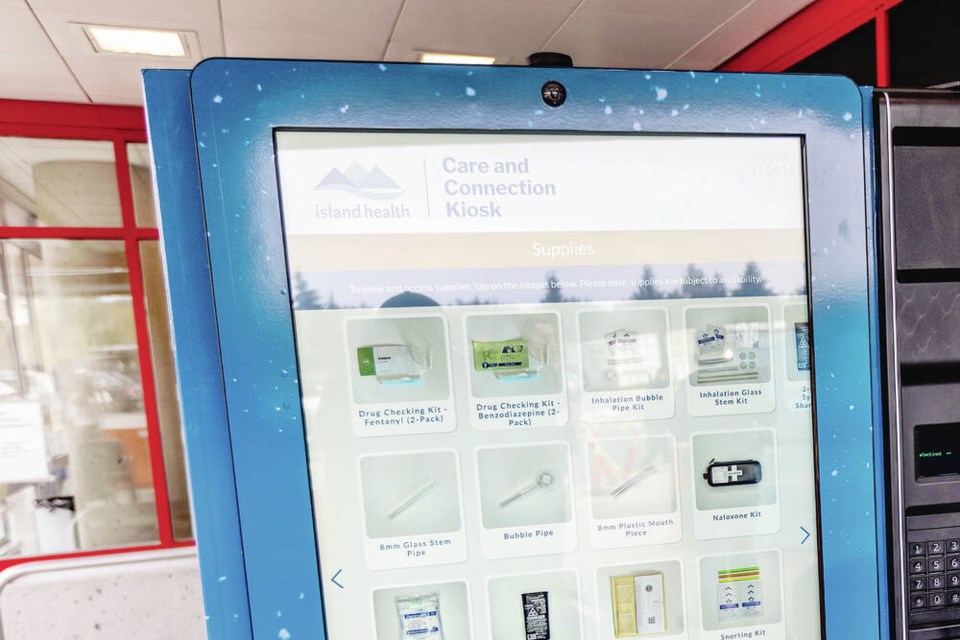Those seeking harm-reduction supplies from Island hospitals can still get them, Island Health says, even though recently installed vending machines have been removed from three facilities pending a provincial review.
Machines installed last fall outside hospital ERs were removed from Nanaimo Regional General Hospital and North Island Hospital in Campbell River on Sept. 4, while one was removed from Victoria General Hospital in mid-December due to the constrained space and inappropriate use of nearby fire alarms and has not been relocated.
The vending machines were intended to reach those who wouldn’t or couldn’t seek in-person services because of their work hours, stigma or fear of repercussions from their employers.
They were also intended to reduce pressure on hospital emergency rooms.
During the review period, those who use drugs and are seeking safe, clean supplies can go to the emergency departments of the three hospitals, where an ambassador or receptionist will direct them to a queue separate from those awaiting emergency treatment.
Staff will give the client the supplies and offer information and treatment options, including opioid agonist therapy — medications such as Suboxone and methadone, the health authority said.
Since the pilot program began last fall, a total of 18,253 items have been dispensed from all three vending machines, which continue to be leased at $2,000 a month each, Island Health said. As of Aug. 28, 8,580 items had been dispensed from the Nanaimo vending machine alone.
Island Health said Premier David Eby has asked for a review of programs where harm-reduction supplies such as needles and inhalation kits are provided without direct interactions between clients and a clinician or peer support worker.
“The review is looking at ways to improve [clients’] connection to the system of care — including treatment options — through in-person interaction at the point of distribution,” the health authority said in a statement.
The vending machines, funded by the Mental Health and Addictions Ministry, were stocked by the B.C. Centre for Disease Control, with peer and addiction recovery workers available to help if needed during business hours.
They dispensed clean syringes, crack pipes, drug-snorting straws, condoms, drug-testing strips, wound-care supplies and naloxone kits, along with information on ways to access mental-health and addiction services.
There are no drugs or medications in the machines, apart from opioid-overdose-reversing naloxone.
Island Health began installing the “Care and Connection” vending machines outside emergency rooms at Victoria General and the Nanaimo and Campbell River hospitals as part of a pilot project to reduce overdose deaths and infections.
But the program came to a halt late last month after some of the supplies were highlighted in a social-media post by former NDP MLA Gwen O’Mahoney, now a B.C. Conservative candidate in Nanaimo-Lantzville.
O’Mahoney, who has family members who have battled addiction, said the vending machines were enabling drug use instead of offering treatment and could trigger people to use drugs or normalize drug use.
As the post gained attention, Eby said he’d requested a review of the vending machines.
The premier said Mental Health and Addictions Minister Jennifer Whiteside was asked to oversee a review of distribution of drug harm-reduction supplies “that don’t involve direct contact between a service provider and somebody struggling with addiction.”
“We want to make sure that people are in contact with the system, that they’re talking to a doctor or a nurse or a social worker or somebody to get them connected into the system, and we also want to keep as many people alive as possible.”
When Island Health introduced the machines last fall, however, the goal was to connect with “hard-to-reach populations like people who work shift work and wouldn’t feel comfortable requesting harm reduction supplies at an overdose prevention site,” Island Health said in a statement this week.
Males using drugs alone at home make up the largest group dying from toxic-drug poisonings. Of those who died in 2023, 70 per cent were age 30 to 59, and 78 per cent were male, according to the B.C. Coroners Service.
About 15,000 people have died from the toxic drug supply since it was declared a public-health emergency in 2016.



